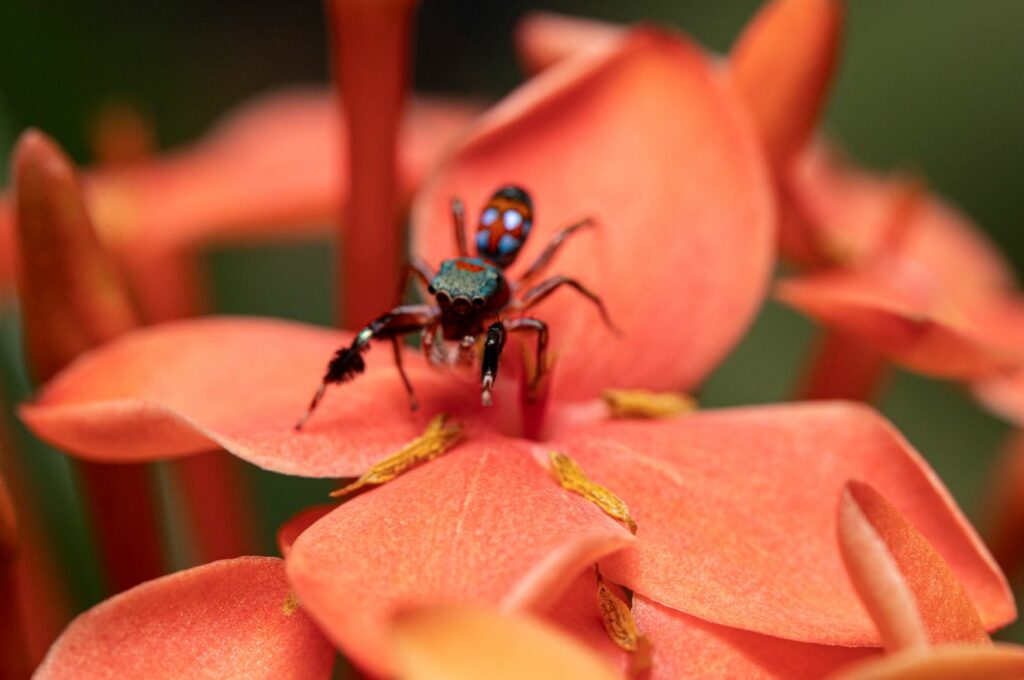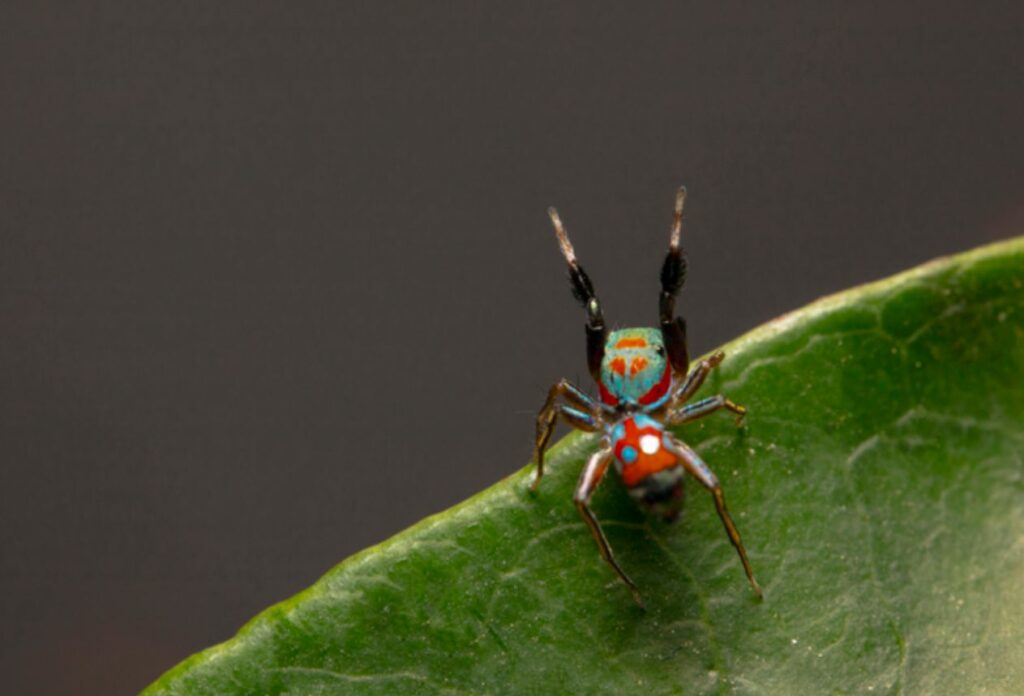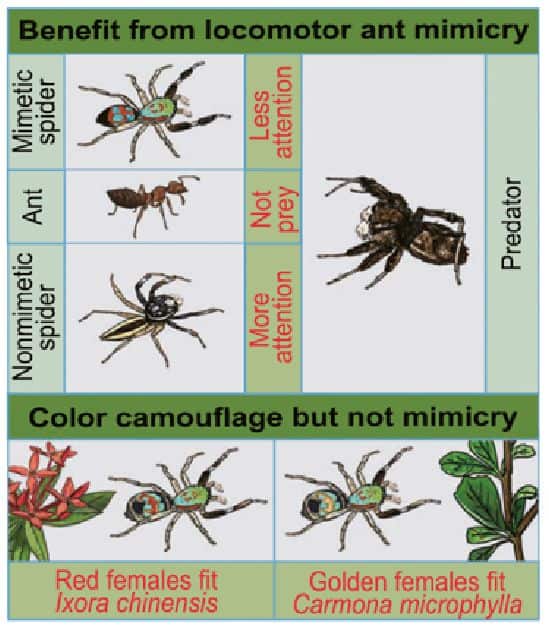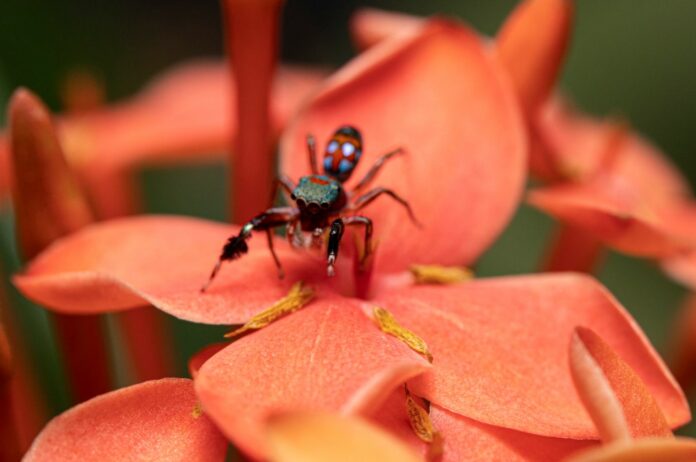Nature’s Stealth Artist: Meet the Spider that Masters Plant Camouflage and Ant Locomotion to Outsmart Predators
A species of tiny, colorful jumping spider employs a dual defense mechanism to avoid becoming prey. By camouflaging with plants and walking like an ant, these spiders successfully evade other spider predators but not praying mantises, according to a recent study published in the journal iScience.
In a notable discovery reported today in the esteemed journal iScience, researchers have unveiled the remarkable defense mechanisms employed by a small, vibrant species of jumping spider. These agile arachnids utilize a dual approach to evade being consumed: blending into their surroundings by camouflaging with plants and imitating the movements of ants. While this clever combination allows them to elude spider predators successfully, it fails to deter hungry praying mantises.
Mimicking ants proves to be a highly effective defense option for spiders, primarily due to ants’ unappetizing qualities as prey. Ants possess spiky defenses, formidable biting mandibles capable of inflicting pain, and a propensity for retaliatory combat. Moreover, many ant species produce chemical repellants or venom. The focus of this study, the Siler collingwoodi spider, was already known to exhibit ant-like locomotion. However, the researchers sought to determine the accuracy of this mimicry, whether it imitates multiple ant species, and how effective it is in discouraging predators.
Additionally, the research team delved into the role played by the spider’s striking coloration, further unraveling the intricacies of their defense strategies.

“Unlike typical ant-mimicking spiders that mimic the brown or black body color of ants, S. collingwoodi has brilliant body coloration,” points out first author Hua Zeng. “From a human’s perspective, it seems to blend well with plants in its environment, but we wanted to test whether their body coloration served as camouflage to protect against predators.”
In an endeavor to unravel the mechanisms behind the effectiveness of ant-mimicry in aiding spider survival, the team embarked on a study that involved collecting wild ant-mimicking spiders from four distinct geographic locations in southern Hainan, China. These specimens were then transported back to the laboratory for analysis. To provide a basis for comparison, the researchers also collected a different type of jumping spider that did not exhibit ant mimicry, along with five coexisting ant species that were hypothesized to serve as potential models.
Once in the laboratory, the researchers meticulously characterized and compared the movement patterns of both the ants and spiders. This involved observing and measuring the utilization of individual limbs, assessing speed, and acceleration, and discerning whether their trajectories followed a linear or convoluted path.

The findings unveiled a remarkable revelation: rather than employing the typical jumping mechanism observed in most jumping spiders, S. collingwoodi spiders showcased ant-like movement patterns. This involved raising their front legs in a manner akin to an ant’s antennae, undulating their abdomens, and adopting a gait reminiscent of ants. Comparative analysis of the five collected ant species revealed that the walking style of the spiders closely resembled that of the three smaller ant species, which also shared a comparable size with the spider species under investigation.
“S. collingwoodi is not necessarily a perfect mimic, because its gait and trajectory showed high similarity with multiple ant species,” adds Zeng. “Being a general mimic rather than perfectly mimicking one ant species could benefit the spiders by allowing them to expand their range if the ant models occupy different habitats.”
The spider’s defenses were then put to the test against two potential predators: the praying mantis (Gonypeta brunneri), a generalist predator with a monochromatic visual system, and Portia labiata, a similarly sized jumping spider with color vision and a preference for preying-on-other-spiders.
To investigate the role of color camouflage, the researchers simulated how the two predators would perceive S. collingwoodi in relation to the other prey species against the backdrop of two plants that the spiders consume: the red-flowering West Indian jasmine (Ixora chinensis) and the Fukien tea tree (Carmona microphylla). On the jasmine plant as opposed to the tea tree plant, they discovered that the ant-mimicking spiders were more successfully hidden from both spider and praying mantis predators.

In a pivotal experiment, the predators were presented with a choice between the ant-mimicking spider and the non-mimicking jumping spider. The results showed that the predatory spider exhibited a preference for attacking the non-mimic. Out of the 17 experiments conducted, the spider launched five attacks, all directed toward the non-mimicking spider. On the other hand, praying mantises displayed an equal propensity for attacking both prey species with unwavering agility.
“We initially thought that both predators would behave similarly in the antipredation experiments, but in fact the simulated ant locomotion of Siler collingwoodi only worked for the jumping spider predator, while the praying mantis showed indiscriminate attacks on both ants and mimics,” adds senior author Wei Zhang.
The variation in feeding behavior between the praying mantises and predatory spiders may stem from the differing risks of injury associated with consuming ants. Due to their significant size advantage over their prey, praying mantises can consume spiny ants without facing serious harm. However, this is not the case for predatory spiders, as the potential risks outweigh the benefits.
“For the spider predator, a random attack on an ant could result in injury, so they are very careful predators and will only attack if they can distinguish S. collingwoodi from ants with a high degree of certainty,” adds Zhang.
However, the loss of a limb significantly compromised the ant-mimicking spiders’ capacity to evade the attention of predatory spiders, likely due to their inability to accurately mimic ants. This impairment resulted from the absence of a limb, which hindered their ability to mimic the precise movements and behaviors of ants effectively.
Image Credit: Hua Zeng, Yuchang Chen and Zeng et al.
